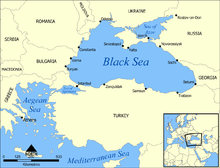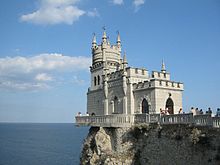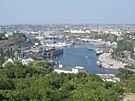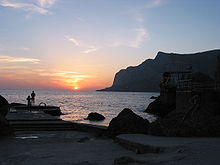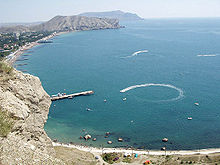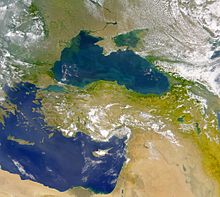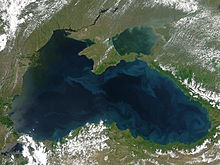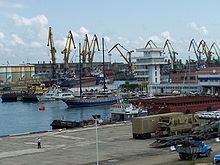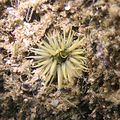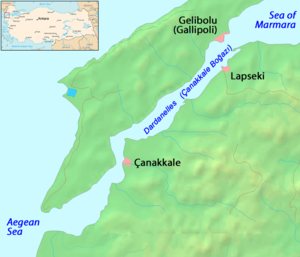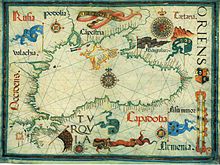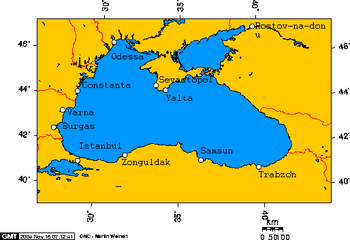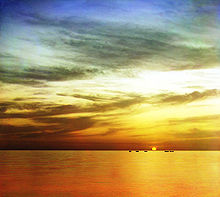
Black Sea
About this schools Wikipedia selection
This Wikipedia selection is available offline from SOS Children for distribution in the developing world. Click here to find out about child sponsorship.
| Coordinates | 44°N 35°E Coordinates: 44°N 35°E |
| Primary outflows | Bosphorus |
| Basin countries | Bulgaria, Romania, Ukraine, Russia, Georgia, Turkey |
| Max length | 1,175 km (730 mi) |
| Surface area | 436,402 km2 (168,500 sq mi) |
| Average depth | 1,253 m (4,111 ft) |
| Max depth | 2,212 m (7,257 ft) |
| Water volume | 547,000 km3 (131,200 cu mi) |
| Islands | 10+ |

The Black Sea is a sea in south-eastern Europe. It is bounded by Europe, Anatolia and the Caucasus and is ultimately connected to the Atlantic Ocean via the Mediterranean and the Aegean Seas and various straits. The Bosphorus Strait connects it to the Sea of Marmara, and the Strait of the Dardanelles connects that sea to the Aegean Sea region of the Mediterranean. These waters separate eastern Europe and western Asia. The Black Sea is also connected to the Sea of Azov by the Strait of Kerch.
The Black Sea has an area of 436,400 km2 (168,500 sq mi) (not including the Sea of Azov), a maximum depth of 2,212 m (7,257 ft), and a volume of 547,000 km3 (131,200 cu mi). The Black Sea forms in an east-west trending elliptical depression which lies between Bulgaria, Georgia, Romania, Russia, Turkey, and Ukraine. It is constrained by the Pontic Mountains to the south, the Caucasus Mountains to the east and features a wide shelf to the northwest. The longest east-west extent is about 1,175 kilometres (730 mi).
Important cities along the coast include Batumi, Burgas, Constanța, Giresun, Hopa, Kerch, Mangalia, Năvodari, Novorossiysk, Odessa, Ordu, Poti, Rize, Samsun, Sevastopol, Sochi, Sukhumi, Trabzon, Varna, Yalta and Zonguldak.
The Black Sea has a positive water balance; that is, a net outflow of water 300 kilometres (190 mi)3 per year through the Bosphorus and the Dardanelles into the Aegean Sea. Mediterranean water flows into the Black Sea as part of a two-way hydrological exchange. The Black Sea outflow is cooler and less saline, and floats over the warm, more saline Mediterranean inflow – as a result of differences in density caused by differences in salinity – leading to a significant anoxic layer well below the surface waters. The Black Sea also receives river water from large Eurasian fluvial systems to the north of the Sea, of which the Don, Dnieper and Danube are the most significant.
In the past, the water level has varied significantly. Due to these variations in the water level in the basin the surrounding shelf and associated aprons have sometimes been land. At certain critical water levels it is possible for connections with surrounding water bodies to become established. It is through the most active of these connective routes, the Turkish Straits, that the Black Sea joins the world ocean. When this hydrological link is not present, the Black Sea is a lake, operating independently of the global ocean system. Currently the Black Sea water level is relatively high, thus water is being exchanged with the Mediterranean. The Turkish Straits connect the Black and Aegean Seas and comprise the Bosphorus, the Sea of Marmara and the Dardanelles.
Extent
The International Hydrographic Organization defines the limits of the Black Sea as follows:
-
- On the Southwest. The Northeastern limit of the Sea of Marmara [A line joining Cape Rumili with Cape Anatoli (41°13'N)].
-
- In the Kertch Strait. A line joining Cape Takil and Cape Panaghia (45°02'N).
Population
| Most populous urban areas along the Black Sea coastline | ||||||||||
|---|---|---|---|---|---|---|---|---|---|---|
|
|
Rank | City | Country | Region/County | Population (urban) | |||||
| 1 | Istanbul | Turkey | Istanbul | 13,624,240 | ||||||
| 2 | Odessa | Ukraine | Odessa | 1,003,705 | ||||||
| 3 | Samsun | Turkey | Samsun | 535,401 | ||||||
| 4 | Sevastopol | Ukraine | Crimea | 379,200 | ||||||
| 5 | Sochi | Russia | Krasnodar Krai | 343,334 | ||||||
| 6 | Varna | Bulgaria | Varna | 334,870 | ||||||
| 7 | Trabzon | Turkey | Trabzon | 305,231 | ||||||
| 8 | Constanța | Romania | Constanța | 254,693 | ||||||
| 9 | Novorossiysk | Russia | Krasnodar Krai | 241,952 | ||||||
| 10 | Zonguldak | Turkey | Zonguldak | 215,407 | ||||||
Name
Modern names
Current names of the Sea are equivalents of the English name, "Black Sea", including:
- Abkhaz: Amshyn Eikʷa (Амшын Еиқәа)
- Adyghe: Khy Shʼutsʼ (Хы ШӀуцӀ)
- Bulgarian: Cherno more (Черно море, IPA: [ˈtʃɛrno moˈrɛ])
- Georgian: Shavi zghva (შავი ზღვა)
- Laz: Ucha zuğa (უჩა ზუღა), or simply Zuğa 'Sea'
- Romanian: Marea Neagră (IPA: [ˈmare̯a ˈne̯aɡrə])
- Russian: Chornoye morye (Чёрное мо́рe, IPA: [ˈtɕɵrnəjə ˈmorʲə]
- Turkish: Karadeniz (IPA: [kaˈɾadeniz])
- Ukrainian: Chorne more (Чорне море, IPA: [ˈtʃɔrnɛ ˈmɔrɛ])
Such names have not yet been shown conclusively to predate the twelfth century, but there are indications that they may be considerably older.
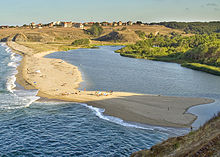
The Black Sea is one of four seas named in English after common colour terms — the others being the Red Sea, the White Sea and the Yellow Sea.
Historical names
Strabo's Geography (1.2.10) reports that in antiquity, the Black Sea was often just called "the Sea" (ho pontos). For the most part, Graeco-Roman tradition refers to the Black Sea as the 'Hospitable sea', Euxeinos Pontos (Εὔξεινος Πόντος). This is a euphemism replacing an earlier 'Inhospitable Sea', Pontos Axeinos, first attested in Pindar (early fifth century BCE,~475 BC). Strabo (7.3.6) thinks that the Black Sea was called "inhospitable" before Greek colonization because it was difficult to navigate, and because its shores were inhabited by savage tribes. The name was changed to "hospitable" after the Milesians had colonized the southern shoreline, the Pontus, making it part of Greek civilization.
It is also possible that the name Axeinos arose by popular etymology from a Scythian Iranic axšaina- 'unlit,' 'dark'; the designation "Black Sea" may thus date from Antiquity.
A map of Asia dating to 1570, entitled "Asiae Nova Descriptio", from Abraham Ortelius's Theatrum Orbis Terrarum, labels the sea Mar Maggior ("Great Sea", cf. Latin mare major).
English-language writers of the 18th century often used the name "Euxine Sea" (pron.: / ˈ j uː k s ɨ n / or / ˈ j uː k ˌ s aɪ n /) to refer to the Black Sea. Edward Gibbon, for instance, calls the sea by this name throughout The History of the Decline and Fall of the Roman Empire.
Geology and bathymetry
The geological origins of the basin can be traced back to two distinct relict back arc basins which were initiated by the splitting of an Albian volcanic arc and the subduction of both the Paleo-and Neo- Tethys Oceans, but the timings of these events remain controversial. Since its initiation, compressional tectonic environments led to subsidence in the basin, interspersed with extensional phases resulting in large-scale volcanism and numerous orogenies, causing the uplift of the Greater Caucasus, Pontides, Southern Crimea and Balkanides mountain ranges. The ongoing collision between the Eurasian and African plates and westward escape of the Anatolian block along the North Anatolian Fault and East Anatolian Faults dictates the current tectonic regime, which features enhanced subsidence in the Black Sea basin and significant volcanic activity in the Anatolian region. It is these geological mechanisms which, in the long term, have caused the periodic isolations of the Black Sea from the rest of the global ocean system.
The modern basin is divided into two sub-basins by a convexity extending south from the Crimean Peninsula. The large shelf to the north of the basin is up to 190 km wide, and features a shallow apron with gradients between 1:40 and 1:1000. The southern edge around Turkey and the western edge around Georgia, however, are typified by a narrow shelf that rarely exceeds 20 km in width and a steep apron that is typically 1:40 gradient with numerous submarine canyons and channel extensions. The Euxine abyssal plain in the centre of the Black Sea reaches a maximum depth of 2,212 metres (7,257.22 feet) just south of Yalta on the Crimean Peninsula.
The littoral zone of the Black Sea is often referred to as the Pontic littoral.
Hydrology and hydrochemistry
The Black Sea is the world’s largest meromictic basin where the deep waters do not mix with the upper layers of water that receive oxygen from the atmosphere. As a result, over 90% of the deeper Black Sea volume is anoxic water. The current hydrochemical configuration is primarily controlled by basin topography and fluvial inputs, which result in a strongly stratified vertical structure and a positive water balance. The upper layers are generally cooler, less dense and less salty than the deeper waters, as they are fed by large fluvial systems, whereas the deep waters originate from the warm, salty waters of the Mediterranean. This influx of dense water from Mediterranean is balanced by an outflow of fresher Black Sea surface-water into the Marmara Sea, maintaining the stratification and salinity levels.
The surface water has an average salinity of 18 to 18.5 parts per thousand or g/L (compared to 30 to 40 for the oceans) and contains oxygen and other nutrients required to sustain biotic activity. These waters circulate in a basin-wide cyclonic shelfbreak gyre known as the Rim Current which transports water round the perimeter of the Black Sea. Within this feature, two smaller cyclonic gyres operate, occupying the eastern and western sectors of the basin. Outside the Rim Current, numerous quasi-permanent coastal eddies are formed as a result of upwelling around the coastal apron and ‘wind curl’ mechanisms. The intra-annual strength of these features is controlled by seasonal atmospheric and fluvial variations. The temperature of the surface waters varies seasonally from −1 °C (30 °F) to 28 °C (82 °F).
Directly beneath the surface waters the Cold Intermediate Layer (CIL) is found. This layer is composed of cool, salty surface waters, which are the result of localised atmospheric cooling and decreased fluvial input during the winter months. The production of this water is focused in the centre of the major gyres and on the NW shelf and as the water is not dense enough to penetrate the deep waters, isopycnal advection occurs, dispersing the water across the entire basin. The base of the CIL is marked by a major thermocline, halocline and pycnocline at ~100–200 m and this density disparity is the major mechanism for isolation of the deep water.
Below the pycnocline, salinity increases to 22 to 22.5 ppt and temperatures rise to around 8.5 °C (47.3 °F). The hydrochemical environment shifts from oxygenated to anoxic, as bacterial decomposition of sunken biomass utilises all of the free oxygen. Certain species of extremophile bacteria are capable of using sulfate (SO42−) in the oxidation of organic material, which leads to the creation of hydrogen sulfide (H2S). This enables the precipitation of sulfides such as the iron sulphides pyrite, and mackinawite, as well as the dissolution of carbonate matter such as calcium carbonate (CaCO3), found in shells. Organic matter, including anthropogenic artifacts such as boat hulls, are well preserved. During periods of high surface productivity, short-lived algal blooms form organic rich layers known as sapropels. Scientists have reported an annual phytoplankton bloom that can be seen in many NASA images of the region. As a result of these characteristics the Black Sea has gained interest from the field of marine archaeology as ancient shipwrecks in excellent states of preservation have been discovered, such as the Byzantine wreck Sinop D, located in the anoxic layer off the coast of Sinop, Turkey.
Modelling shows the release of the hydrogen sulphide clouds in the event of an asteroid impact into the Black Sea would pose a threat to health—or even life—for people living on the Black Sea coast.
Ecology
The Black Sea supports an active and dynamic marine ecosystem, dominated by species suited to the brackish, nutrient-rich, conditions. As with all marine food webs, the Black Sea features a range of trophic groups, with autotrophic algae, including diatoms and dinoflagellates, acting as primary producers. The fluvial systems draining Eurasia and central Europe introduce large volumes of sediment and dissolved nutrients into the Black Sea, but distribution of these nutrients is controlled by the degree of physiochemical stratification, which is, in turn, dictated by seasonal physiographic development. During winter, strong wind promotes convective overturning and upwelling of nutrients, while high summer temperatures result in a marked vertical stratification and a warm, shallow mixed layer. Day length and insolation intensity also controls the extent of the photic zone. Subsurface productivity is limited by nutrient availability, as the anoxic bottom waters act as a sink for reduced nitrate, in the form of ammonia. The benthic zone also plays an important role in Black Sea nutrient cycling, as chemosynthetic organisms and anoxic geochemical pathways recycle nutrients which can be upwelled to the photic zone, enhancing productivity.
Phytoplankton
The main phytoplankton groups present in the Black Sea are dinoflagellates, diatoms, coccolithophores and cyanobacteria. Generally, the annual cycle of phytoplankton development comprises significant diatom and dinoflagellate-dominated spring production, followed by a weaker mixed assemblage of community development below the seasonal thermocline during summer months and a surface-intensified autumn production. This pattern of productivity is also augmented by an Emiliania huxleyi bloom during the late spring and summer months.
- Dinoflagellates
- Annual dinoflagellate distribution is defined by an extended bloom period in subsurface waters during the late spring and summer. In November, subsurface plankton production is combined with surface production, due to vertical mixing of water masses and nutrients such as nitrite. The major bloom-forming dinoflagellate species in the Black Sea is Gymnodinium sp. Estimates of dinoflagellate diversity in the Black Sea range from 193 species to 267 species. This level of species richness is relatively low in comparison to the Mediterranean Sea, which is attributable to the brackish conditions, low water transparency and presence of anoxic bottom waters. It is also possible that the low winter temperature <4 °C of the Black Sea prevent thermophilous species from becoming established. The relatively high organic matter content of Black Sea surface water favour the development of heterotrophic (an organism which uses organic carbon for growth) and mixotrophic dinoflagellates species (able to exploit different trophic pathways), relative to autotrophs. Despite its unique hydrographic setting, there are no confirmed endemic dinoflagellate species in the Black Sea.
- Diatoms
- The Black Sea is populated by many species of marine diatom, which commonly exist as colonies of unicellular, non-motile auto- and heterotrophic algae. The life-cycle of most diatoms can be described as 'boom and bust' and the Black Sea is no exception, with diatom blooms occurring in surface waters throughout the year, most reliably during March. In simple terms, the phase of rapid population growth in diatoms is caused by the in-wash of silicon-bearing terrestrial sediments, and when the supply of silicon is exhausted, the diatoms begin to sink out of the photic zone and produce resting cysts. Additional factors such as predation by zooplankton and ammonium-based regenerated production also have a role to play in the annual diatom cycle. Typically, Proboscia alata blooms during spring and Pseudosolenia calcar-avis blooms during the autumn.
- Coccolithophores
- Coccolithophores are a type of motile, autotrophic phytoplankton that produce CaCO3 plates, known as coccoliths, as part of their life cycle. In the Black Sea, the main period of coccolithophore growth occurs after the bulk of the dinoflagellate growth has taken place. In May, the dinoflagellates move below the seasonal thermocline, into deeper waters, where more nutrients are available. This permits coccolithophores to utilise the nutrients in the upper waters, and by the end of May, with favourable light and temperature conditions, growth rates reach their highest. The major bloom forming species is Emiliania huxleyi, which is also responsible for the release of dimethyl sulfide into the atmosphere. Overall, coccolithophore diversity is low in the Black Sea, and although recent sediments are dominated by E. huxleyi, Braarudosphaera bigelowii, Holocene sediments have also been shown to contain Helicopondosphaera and Discolithina species.
- Cyanobacteria
- Cyanobacteria are a phylum of picoplanktonic (plankton ranging in size from 0.2 – 2 micrometre) bacteria that obtain their energy via photosynthesis, and are present throughout the world's oceans. They exhibit a range of morphologiies, including filamentous colonies and biofilms. In the Black Sea, several species are present, and as an example, Synechococcus spp. can be found throughout the photic zone, although concentration decreases with increasing depth. Other factors which exert an influence on distribution include nutrient availability, predation and salinity.
- Zebra mussel
- The Black Sea along with the Caspian Sea is part of the Zebra mussel's native range. The mussel has been accidentally introduced around the world and become an invasive species where it has been introduced.
- Common Carp
- The Common Carp's native range extends to The Black Sea along with the Caspian Sea and Aral Sea. Like the Zebra mussel the Common Carp is an invasive species when introduced to other habitats.
- Round Goby
- Is another native fish that is also found in the Caspian Sea. It preys upon Zebra mussels. Like the mussels and common carp it has become invasive when introduced to other environments, like the Great Lakes.
Effect of pollution ecology
Since the 1960s, rapid industrial expansion along the Black Sea coast line and the construction of a major dam has significantly increased annual variability in the N:P:Si ratio in the basin. In coastal areas, the biological effect of these changes has been an increase in the frequency of monospecific phytoplankton blooms, with diatom bloom frequency increasing by a factor of 2.5 and non-diatom bloom frequency increasing by a factor of 6. The non-diatoms, such as the prymnesiophytes Emiliania huxleyi (coccolithophore), Chromulina sp., and the Euglenophyte Eutreptia lanowii are able to out-compete diatom species because of the limited availability of Si, a necessary constituent of diatom frustules. As a consequence of these blooms, benthic macrophyte populations were deprived of light, while anoxia caused mass mortality in marine animals.
The decline in macrophytes was further compounded by overfishing during the 1970s, while the invasive ctenophore Mnemiopsis reduced the biomass of copepods and other zooplankton in the late 1980s. Additionally, an alien species—the warty comb jelly (Mnemiopsis leidyi)—was able to establish itself in the basin, exploding from a few individuals to an estimated biomass of one billion metric tons. The change in species composition in Black Sea waters also has consequences for hydrochemistry, as Ca-producing coccolithophores influence salinity and pH, although these ramifications have yet to be fully quantified. In central Black Sea waters, Si levels were also significantly reduced, due to a decrease in the flux of Si associated with advection across isopycnal surfaces. This phenomenon demonstrates the potential for localised alterations in Black Sea nutrient input to have basin-wide impacts.
Pollution reduction and regulation efforts have led to a partial recovery of the Black Sea ecosystem during the 1990s, and an EU monitoring exercise, 'EROS21', revealed decreased N and P values, relative to the 1989 peak. Recently, scientists have noted signs of ecological recovery, in part due to the construction of new sewage treatment plants in Slovakia, Hungary, Romania, and Bulgaria in connection with membership in the European Union. Mnemiopsis leidyi populations have been checked with the arrival of another alien species which feeds on them.
-
Stingray, near Romanian coast
Climate
Short-term climatic variation in the Black Sea region is significantly influenced by the operation of the North Atlantic Oscillation, the climatic mechanisms resulting from the interaction between the north Atlantic and mid-latitude air masses. While the exact mechanisms causing the North Atlantic Oscillation remain unclear, it is thought the climate conditions established in western Europe mediate the heat and precipitation fluxes reaching Central Europe and Eurasia, regulating the formation of winter cyclones, which are largely responsible for regional precipitation inputs and influence Mediterranean Sea Surface Temperatures (SST's). The relative strength of these systems also limits the amount of cold air arriving from northern regions during winter. Other influencing factors include the regional topography, as depressions and storms systems arriving from the Mediterranean are funneled through the low land around the Bosphorus, Pontic and Caucasus mountain ranges acting as wave guides, limiting the speed and paths of cyclones passing through the region
Mediterranean connection during the Holocene
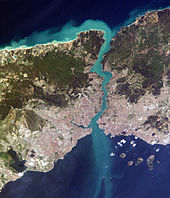
The Black Sea is connected to the World Ocean by a chain of two shallow straits, the Dardanelles and the Bosphorus. The Dardanelles is 55 m (180 ft) deep and the Bosphorus is as shallow as 36 m (118 ft). By comparison, at the height of the last ice age, sea levels were more than 100 m (330 ft) lower than they are now. There's also evidence that water levels in the Black Sea, too, were considerably lower at some point during the post-glacial period. Thus, for example, archaeologists found fresh-water snail shells and man-made structures in roughly 100 m (330 ft) of water off the Black Sea coast of modern Turkey. Therefore it is agreed that the Black Sea has been a landlocked freshwater lake (at least in upper layers) during the last glaciation and for some time after.
In the aftermath of the Ice Age, water levels in the Black Sea and the Aegean Sea rose independently until they were high enough to exchange water. The exact timeline of this development is still subject to debate. One possibility is that the Black Sea filled first, with excess fresh water flowing over the Bosphorus sill and eventually into the Mediterranean Sea. There are also catastrophic scenarios, such as the " Black Sea deluge theory" put forward by William Ryan and Walter Pitman.
Deluge hypothesis
In 1997, William Ryan and Walter Pitman from Columbia University published a hypothesis according to which a massive flood through the Bosphorus occurred in ancient times. They claim that the Black and Caspian Seas were vast freshwater lakes, but then about 5600 BC, the Mediterranean spilled over a rocky sill at the Bosphorus, creating the current communication between the Black and Mediterranean Seas. Subsequent work has been done both to support and to discredit this hypothesis, and archaeologists still debate it. This has led some to associate this catastrophe with prehistoric flood myths.
History
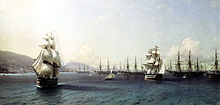
The Black Sea was a busy waterway on the crossroads of the ancient world: the Balkans to the West, the Eurasian steppes to the north, Caucasus and Central Asia to the East, Asia Minor and Mesopotamia to the south, and Greece to the south-west. The oldest processed gold in the world, arguably left by Old Europeans, was found in Varna, and the Black Sea was supposedly sailed by the Argonauts. The land at the eastern end of the Black Sea, Colchis, (now Georgia), marked for the Greeks the edge of the known world. The steppes to the north of the Black Sea have been suggested as the original homeland ( Urheimat) of the speakers of the Proto-Indo-European language, (PIE) the progenitor of the Indo-European language family, by some scholars such as Kurgan; others move the heartland further east towards the Caspian Sea, yet others to Anatolia). Numerous ancient ports, some older than the Egyptian pyramids, line the Black Sea's coasts.
The Black Sea became an Ottoman Navy lake within five years of Genoa losing the Crimea in 1479, after which the only Western merchant vessels to sail its waters were those of Venice's old rival Ragusa. This restriction was gradually changed by the Russian Navy from 1783 until the relaxation of export controls in 1789 because of the French Revolution.
The Black Sea was a significant naval theatre of World War I and saw both naval and land battles during World War II.
Archaeology
Ancient trade routes in the region are currently being extensively studied by scientists, as the Black Sea was sailed by Hittites, Carians, Thracians, Greeks, Persians, Cimmerians, Scythians, Romans, Byzantines, Goths, Huns, Avars, Bulgars, Slavs, Varangians, Crusaders, Venetians, Genoese, Lithuanians, Georgians, Poles, Tatars, Ottomans, and Russians. Perhaps the most promising areas in deepwater archaeology are the quest for submerged prehistoric settlements in the continental shelf and for ancient shipwrecks in the anoxic zone, which are expected to be exceptionally well preserved due to the absence of oxygen. This concentration of historical powers, combined with the preservative qualities of the deep anoxic waters of the Black Sea, has attracted increased interest from marine archaeologists who have begun to discover a large number of ancient ships and organic remains in a high state of preservation.
Holiday resorts and spas
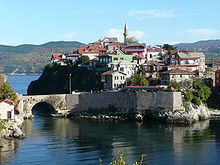
In the years following the end of the Cold War, the popularity of the Black Sea as a tourist destination steadily increased. Tourism at Black Sea resorts became one of the region's growth industries. The following is a list of well-known Black Sea resorts:
- 2 Mai (Romania)
- Agigea (Romania)
- Ahtopol (Bulgaria)
- Amasra (Turkey)
- Anaklia (Georgia)
- Anapa (Russia)
- Albena (Bulgaria)
- Alupka (Crimea, Ukraine)
- Alushta (Crimea, Ukraine)
- Balchik (Bulgaria)
- Batumi (Georgia)
- Burgas (Bulgaria)
- Byala (Bulgaria)
- Chakvi (Georgia)
- Constantine and Helena (Bulgaria)
- Corbu (Romania)
- Costineşti (Romania)
- Eforie (Romania)
- Emona (Bulgaria)
- Eupatoria (Crimea, Ukraine)
- Foros (Crimea, Ukraine)
- Feodosiya (Crimea, Ukraine)
- Giresun (Turkey)
- Gagra (Abkhazia, Georgia1)
- Gelendzhik (Russia)
- Golden Sands (Bulgaria)
- Gonio (Georgia)
- Gurzuf (Crimea, Ukraine)
- Hopa (Artvin, Turkey)
- Istanbul (Turkey)
- Jupiter (Romania)
- Kamchia (Bulgaria)
- Kavarna (Bulgaria)
- Kiten (Bulgaria)
- Kobuleti (Georgia)
- Koktebel (Crimea, Ukraine)
- Lozenetz (Bulgaria)
- Mamaia (Romania)
- Mangalia (Romania)
- Năvodari (Romania)
- Neptun (Romania)
- Nesebar (Bulgaria)
- Novorossiysk (Russia)
- Ordu (Turkey)
- Obzor (Bulgaria)
- Odessa (Ukraine)
- Olimp (Romania)
- Pitsunda (Abkhazia, Georgia1)
- Pomorie (Bulgaria)
- Primorsko (Bulgaria)
- Rize (Turkey)
- Rusalka (Bulgaria)
- Samsun (Turkey)
- Saturn (Romania)
- Sinop (Turkey)
- Sochi (Russia)
- Sozopol (Bulgaria)
- Sudak (Crimea, Ukraine)
- Skadovsk (Ukraine)
- Sulina (Romania)
- Sunny Beach (Bulgaria)
- Şile (Turkey)
- Sveti Vlas (Bulgaria)
- Trabzon (Turkey)
- Tsikhisdziri (Georgia)
- Tuapse (Russia)
- Ureki (Georgia)
- Vama Veche (Romania)
- Varna (Bulgaria)
- Venus (Romania)
- Yalta (Crimea, Ukraine)
- Zonguldak (Turkey)
1 Abkhazia has been a de facto independent republic since 1992, although remains a de jure autonomous republic of Georgia.
International and military use of the Turkish Straits
The 1936 Montreux Convention provides for a free passage of civilian ships between the international waters of the Black and the Mediterranean Seas. However, a single country (Turkey) has a complete control over the straits connecting the two seas. The 1982 amendments to the Montreux Convention allow Turkey to close the Straits at its discretion in both wartime and peacetime. The 1936 Montreux Convention governs the passage of vessels between the Black and the Mediterranean Seas and the presence of military vessels belonging to non- littoral states in the Black Sea waters.
